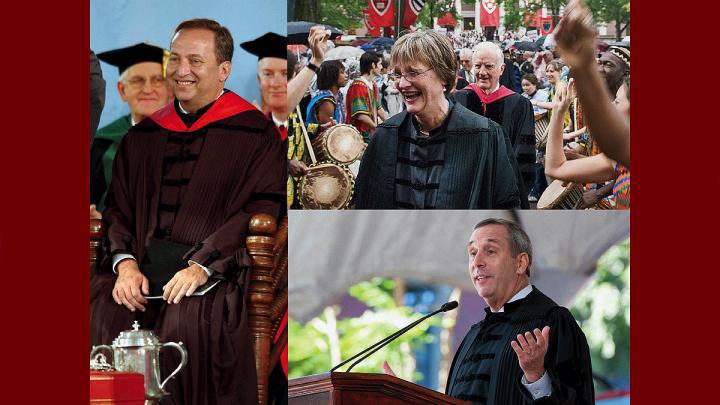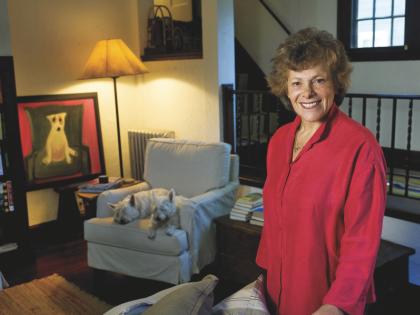Commencements provide annual practice in uniting the Harvard community and celebrating its members, performing rituals, and parading around in funny costumes. Installations may appear similar, but are relatively infrequent (Claudine Gay’s, on September 29, launches just the thirtieth University president), more personal, one-off events. As such, they may signal new leaders’ interests and temperament. With benefit of hindsight, here are some of the messages sent during this millennium’s three prior ceremonies.
Lawrence H. Summers’s installation, on October 11-12, 2001, took place in the shadow of the 9/11 attacks, so before the main Friday afternoon ceremony, a bomb-sniffing dog and handler swept the Tercentenary Theatre stage—separated from the audience by a security fence draped in crimson and white cloths.
During the morning’s half-dozen symposiums, an academic agenda could be discerned, heavy on science and globalization, plus professorial perspectives on art and culture and on undergraduate education. In the afternoon ceremony, Undergraduate Council president Paul A. Gusmorino III ’02 spoke: apparently the first College student to do so on such an occasion—an indication of Summers’s interest in refashioning undergraduate education. In Summers’s address, the first of the Harvard challenges he enumerated was “ensuring that teaching and learning are everything they can be here, especially at…Harvard College.” He also emphasized extending scientific research. The first theme yielded liberalized terms for study abroad and spurred fresh thinking about pedagogy. (His initiative to overhaul the curriculum alienated faculty members who believed they were responsible for such matters.) His most ambitious plans for accelerated construction of science facilities in Allston were not realized, but Summers launched an era of signal Harvard investments in sciences such as the Broad Institute, new Medical School disciplines, and expanded Faculty of Arts and Sciences labs.
In advocating better science education, Summers unveiled a tougher style: “[W]e live in a society, and dare I say a University, where few would admit…to not having read any plays by Shakespeare…but where it is all too common and all too acceptable to not know a gene from a chromosome or the meaning of exponential growth.” Other hints of those instincts emerged. He said perhaps the most important creative tension within the University was that “we carry ancient traditions, but what is new is most important for us.” In pursuing the new, the man who said, “I pledge my energy to Harvard’s work,” also told the crowd, “[M]uch as I admire…Love Story, I do not believe that being president means never having to say you’re sorry.”
Somewhat removed from the horrors of 9/11, and before the financial crisis that would redirect her presidency a year later, the installation of Drew Gilpin Faust, October 11-12, 2007, set a different tone. A historian, she called universities “uniquely accountable to the past and to the future,” requiring massive investments in older facilities like the art museums and the undergraduate Houses, but also in the newly organized School of Engineering and Applied Sciences.
Coming 16 months after the end of the Summers administration, and Derek Bok’s encore in an interim capacity, the whole inauguration was more relaxed even though energized by the Faust precedent (as Harvard’s first Southern president, Penn’s Amy Gutmann joked—and first woman leader). Faust had family members read from Governor John Winthrop and from Abraham Lincoln at the morning prayer service, but also from Dr. Seuss. The Thursday evening musical prelude featured a “primer” on leadership with film clips of experts like Groucho Marx and Frankenstein.
Faust’s upbringing in the segregated South and subsequent involvement in civil rights (see page 37) were reflected in the array of guests and performers—from Toni Morrison, Litt.D. ’89, and John Hope Franklin, Ph.D. ’41, LL.D. ’81, to the Kuumba Singers and saxophonist Joshua Redman ’91 (plus an exhibition of works by Kara Walker)—and in a rendition of “Amazing Grace” before the final singing of “Fair Harvard.”
Her paramount interest in unifying the community after a divisive period was underscored in ways small and large. One was the involvement of family members throughout: the image of togetherness. Another was the unusual gesture of inviting predecessors Neil L. Rudenstine, Summers, and Bok to sit on the stage and help confer the symbols of office. Turning to the University’s reasons for being, the topics for the five morning academic symposiums were interdisciplinary: the on-ramp to Faust’s One Harvard. The most vivid way of expressing this aspiration was invoking Winthrop’s call to the settlers of the Massachusetts Bay Colony to be “knitt together in this work as one,” underscoring an appeal to come together to advance “the purposes and potential of this university and…all it can do to shape how the world will look” in the future.
In the event, external crises—the financial meltdown of 2008 and the Great Recession—and Harvard’s ensuing multibillion-dollar losses forced the University to come together in a period of retrenchment that no one had anticipated or hoped for, and to emerge, courtesy of the Harvard Campaign, with new ways of collaborating.
If Faust situated universities as bridges between the past (arts and museums, libraries and collections) and the future (discovery and teaching), Lawrence S. Bacow’s installation, on October 5, 2018, was focused on the present, which he perceived as “challenging times for higher education in America.” Against a backdrop of criticisms (college costs too much and has become narrow-minded) and threats (facts can be reduced to opinions; attacks on immigration and diversity), much of his address focused externally. He reaffirmed the core beliefs that “higher education is a public good worthy of support—and beyond that, a pillar of our democracy, that if dislodged, will change the United States into something fundamentally bleaker and smaller.” In doing so, he restated Harvard’s commitments to open discourse and discovery of truth, and to welcoming talented people from around the globe and every walk of life.
Internally, Bacow’s messages were more tonal and cultural. At the Thursday night artistic showcase, student and faculty performers (their ranks augmented by Faust’s arts initiatives) earned raves from the Bacows, plural. Adele Fleet Bacow hailed the performers for demonstrating “the passion, the soul of Harvard.” The president thanked the people backstage who had made the evening possible. The next morning, the couple grazed through a continental breakfast, seemingly taking in every exhibit on projects and programs from across Harvard.
That afternoon, all four living Harvard presidents emeriti helped invest Bacow with the symbols of office. In his address, he thanked those who had helped him in life, from his immigrant parents and Adele and their children to his Harvard dissertation advisers (who were in the parade) and colleagues from Tufts and MIT. And he spoke about some of the behaviors he had modeled: “We need to teach our students to be quick to understand, and slow to judge”—a duty faculty owe one another, as well. He warned against hubris, discerning the risk that critics who assert that “we care more about making our institutions great than about making the world better” might be onto something. After, the Bacows’ rabbi and friend, Wesley Gardenswartz ’83, J.D. ’86, offered intensely personal, emotional blessings—another display of Bacow’s values and guiding lights.
Then it was time for an informal, egalitarian “Bacow Block Party” in the Old Yard, with food, entertainment, and the newly installed president dancing, granddaughter in arms, and leaving his mark, in Sharpie, as “Larry 29.” Bacow would be given less than two years before his Harvard presidential crisis: the March 10, 2020, decision to close campus as the COVID-19 pandemic erupted. Understandably, his efforts to buttress higher education across the land had to be set aside. But the personal examples and moral precepts he conveyed did much to bring the University through a seemingly existential moment, able to emerge with new intellectual energies and the resources to support them.
With that, the community anticipates September 29, attentive to the enthusiasms and manner of its new leader, whose election begins a generational transition in Massachusetts Hall. President Gay, the floor is yours.
—John S. Rosenberg








